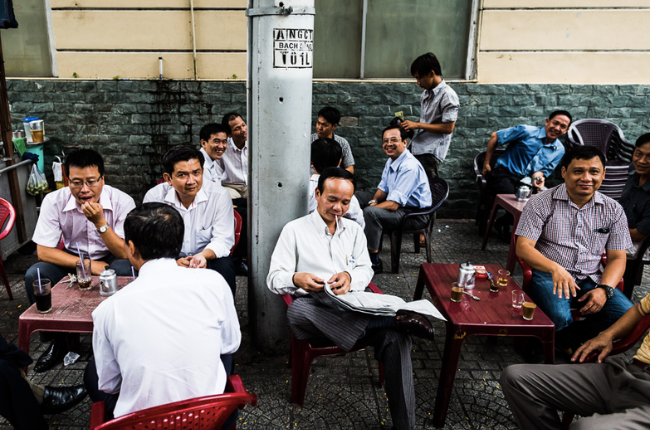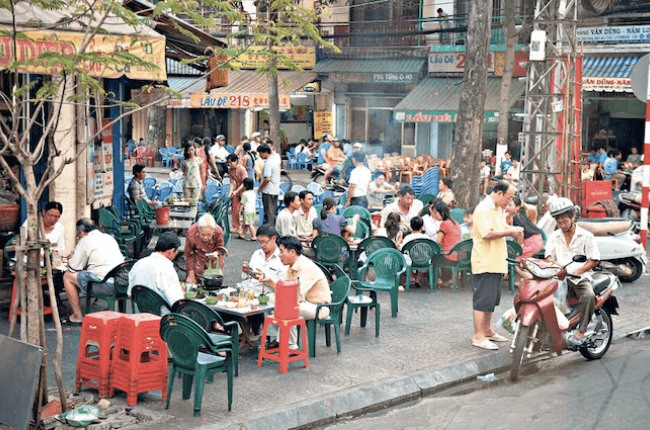Walking down the street in Vietnam is not the same as walking down the street in the West and is full of sights, sounds and smells that may well surprise you. Some of these are great – others not so much – however all are pretty fascinating!
The street itself
When you walk down the street in Vietnam, the first thing you will notice is the fact that although many roads have pavements, these are not dedicated to pedestrians and instead are crowded with motorbikes, small stools, and mini tables for cafes, sellers of various goods and even some rounded cages for animals such as chickens and roosters. This means that you have to have your wits about you as you need to be vigilant of all these things that you need to avoid rather than simply walking in a straight line along the pavement as you may well expect.
In addition to the crowded pavement, it is important to note that unlike the West in which pavements are required to be constantly maintained so that they are smooth and easy to walk on, in Vietnam the pavement may well have holes (some of which are quite large) and sections which have come away, etc. This means that you do need to look at where you are stepping instead of confidently striding ahead. On the positive side, however, these very uneven pavements are very good for your hips as the uneven surface makes your hips work more than they would on a flat surface – there is always a positive side to everything!!
>> Read more: Top 8 expat towns in Vietnam you should know
The rubbish
As you walk down the street in Vietnam, although there are rubbish trucks, the majority of the cleaning of the street in the middle of the towns is done by people in the shops directly behind the pavement. It is a common sight to see the shop keeper starting their day by sweeping the area in front so that is nice and clean – and this means that on the pavement itself, there is little rubbish spread around. However, in the area between the edge of the road and the pavement, there are often small rubbish piles where people have swept it all and it will be collected later on. It doesn’t interfere with your walking that much – simply step over or around it.
The rubbish is found on streets (Source: Internet)
The motorbikes
Motorbikes are the biggest problem on the pavement for two main reasons when you walk down the street in Vietnam. The first is that motorbikes often travel on the pavements – this may be because there is a traffic jam on the road so bikers are making a detour on the pavement or alternatively if the street is a one-way street then bikers will travel on the pavement the wrong way.
Although there are parking areas, typically most shops will not have a parking area nearby and since most of their customers will travel to the shop by motorbike, then when they wish to visit the shop they will simply park outside the shop on the pavement. This often means that the pavement is totally full of motorbikes and there is no space to pass by when walking. If this is the case, then you need to make a detour into the road ( being vigilant for motorbikes as you need to have the awareness that motorbikes may be coming in both directions ).
>> Read more: Guide to parking your motorbike in Vietnam
Pop up cafes
You will find that when you walk down the street in Vietnam, it is a place where people eat – although some cafes have proper awnings etc and the street section is part of the main café, the majority of them are simply pop-up cafes. The most popular will be a kind of cart which has all of the cooking materials on it and serves as the kitchen area. One section of the cart will have carried the mini stools and these are then spread out on the pavement to become the seating area. This means that the whole pavement will be taken up with stools and people eating, thus you have a choice to either walk in between the people and thus potentially disturb their eating or skirt around them – walking in the road.
Pavements are often taken up with café seating areas (Source: Internet)
The sellers
You will find that in the centre of towns/cities (particularly in the tourist areas ) there are a lot of sellers – these can be people who have a cloth laid out on a cart or on the floor and have spread goods out on them or have a cart with items to sell on. In addition, there will be many ladies with the traditional double baskets balanced on a pole which is carried along on a shoulder. These ladies typically sell fruit or snacks and can be quite persistent. One common ploy is to seem to give you something – it is a natural reaction to accept something which someone is giving you – however, once you have accepted it then you need to purchase it!
When you walk down the street in Vietnam, it is important to remember that the people who are selling on the street are not there for fun – this is their livelihood and they have hard lives. As a result, although it is easy to be irritated with people badgering you to buy things, it is better to simply decline if you don’t want anything or purchase with a smile if you do!
Sellers take up a lot of pavement
>> Read more: 6 most common payment methods in Vietnam
The selfies
As you walk down the street in Vietnam you will find people taking photographs everywhere you look. Photographs are immensely popular in Vietnam and you will find that there are lots of photo opportunity places set up in tourist areas and shops so that people can have an amazing background for their selfies.
As a foreigner, you will find that many people are keen to have their photograph taken with you ( with this being even more popular the more you leave the cities) It is up to you whether you want to have your photo taken or not – it is fine to politely say no if you don’t want to and very easy to just smile at the camera if you chose to do so!
When walking down the street you will sometimes invariably need to step in front of the photo-taking to carry on your path – although you can try and wait until the photo has been taken you will find that the photographs are not simply a point and press as in the West but much more of an elaborate set up with various poses and things to hold etc – so it is not easy to wait. Instead, use your judgement of politeness – pause a little before you march straight in front and try to let people see that you are going to walk ahead so that they can hold off for a second or two.
Overall, the street in Vietnam is an amazing place – full of energy and life. It is not easy to simply walk down the street in a straight line with all that is going on in the lively street but as long as you are not trying to march from A to B at high speed then you will find it a place of fun and excitement – so accept it for what it is – and take time to meander instead of walk.








